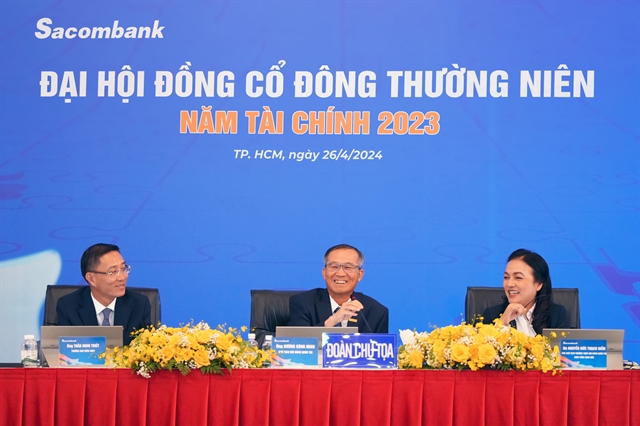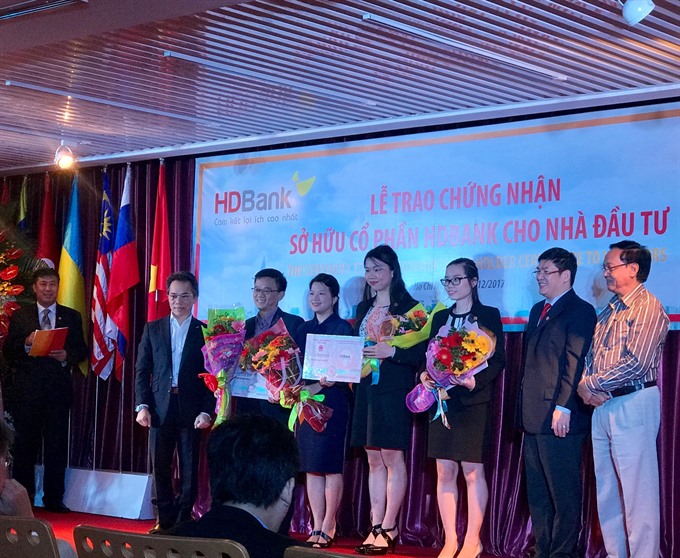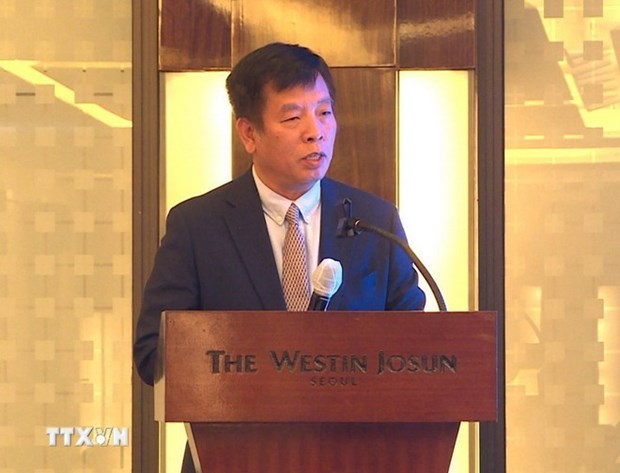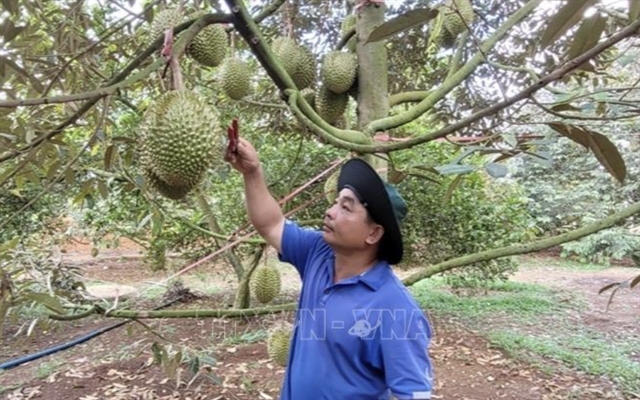 Business Beat
Business Beat

Since last year there has been a churn in the banking sector with some foreign investors selling their stakes in local banks and others buying in.
 |
In December Hồ Chí Minh Development Joint Stock Commercial Bank (HDBank) had sold stakes to more than 76 foreign investors before listing.— Photo ndh.vn |
by Thiên Lý
Since last year there has been a churn in the banking sector with some foreign investors selling their stakes in local banks and others buying in.
France’s BNP Paribas, HSBC and Australia’s Commonwealth Bank have been among those pulling out.
ANZ sold its retail banking division to Korea’s Shinhan Bank and Standard Chartered Bank sold its entire 8.75 per cent stake in Asia Commercial Bank.
Analysts said foreign banks are merely pulling out to invest in more profitable markets.
Some pointed out that Asian banks which enter Việt Nam seem to be more successful than their western counterparts. They attributed this to their better understanding of the local market and business culture.
But even in the case of western funds, the flow is not one-way: Just this month Việt Nam Technological and Commercial Joint Stock Bank (Techcombank) revealed it is selling stakes worth over US$370 million to US private equity firm Warburg Pincus.
In December Hồ Chí Minh Development Joint Stock Commercial Bank (HDBank) had sold stakes to more than 76 foreign investors before listing.
The investors include some familiar names like VinaCapital, Dragon Capital, Deutsche Bank AG, JPMorgan Vietnam Opportunities Fund and financial institutions like CAM Bank (Japan), RWC Frontier Markets Opportunity Master Fund (UK), Macquarie Bank (Australia), and Charlemagne (UK).
HDBank’s partner in the consumer finance division, Credit Saison (Japan), also bought a stake.
In all investors paid $300 million for a 21.5 per cent stake in HDBank.
Finnish independent fund management company PYN Fund Management recently completed acquisition of a 4.99 per cent stake in Tiền Phong Commercial Joint Stock Bank (TPBank) for $40 million, marking its largest investment yet in Việt Nam.
With a total portfolio value of 417 million euros, PYN is now the third largest foreign investment fund in Việt Nam.
South-Korean based Hana Financial Group has acquired a stake in the Bank for Investment and Development of Vietnam (BIDV).
The banking sector is at an historic point now, with a cleaning up of books well under way. The real estate market is booming, meaning banks’ bad debts are being settled increasingly and their revenues are increasing.
But for analysts the most important factor is that the Government is forcing banks to meet Basel II standards.
They said foreign investors recognise the potential of Việt Nam’s financial market, especially on mobile platforms, since the country has 53 million mobile subscribers and 40 million users.
The Government is making policy changes that would help the industry overcome its limitations in technology, capital and management, making foreign investors feel secure.
While foreign investors would like to woo Vietnamese banks, they are hamstrung by the fact that most of the latter have reached or are close to reaching foreign ownership caps.
Vietnamese law allows maximum ownership of a bank by a single foreign investor of 20 per cent and combined ownership by foreign entities of 30 per cent.
Based on these numbers, only a few banks remain below the threshold, most of them still in the process of restructuring, including SCB, BacA Bank, VietABank, and Sacombank.
Many lenders have suggested that the State Bank of Việt Nam should increase the foreign ownership caps to 35-40 per cent in case of State-owned banks and 49-51 per cent in case of private banks.
Foreign investors want the ratio to be increased to 50 per cent or even 65 per cent.
Traditional grocers lose out to modern retail
Hai Hương, 66, owns a small grocery store in an alley off Huỳnh Đình Hai Street in HCM City’s Bình Thạnh District. The shop has helped her run her family for the last 20-odd years.
But now she plans to close it following a terminal slump and bad losses in recent times.
“Business has dropped day after day,” she said.
Most of her once-regular customers have switched to convenience stores or mini supermarkets, which are mushrooming in that area.
But she admitted their choice was easy to understand because the modern retail stores have a huge range of products, a majority of them of high quality, and routinely offer promotions.
“I cannot compete with them,” she said.
Thousands of these so-called mom and pop shops in cities and towns around the country face a similar fate as modern retail shops spring up everywhere.
According to a recent survey by the Việt Nam High Quality Goods Association, traditional grocery shops’ share of business has gone down from 17 per cent in 2011 to 9 per cent now.
From just two supermarkets in HCM City in the late 1990s growth has been dizzying and now there are thousands of modern stores of all types around the country. By 2015 there were round 2,000 convenience stores and mini supermarkets.
Vinmart+ for instance entered the retail business only three years ago but has already become the biggest convenience store chain in the country with 1,000 outlets.
According to IDG research Việt Nam’s convenience store market is expected to grow at 37.4 per cent annually, the highest rate in Asia.
A recent report by Kantar Worldpanel said the modern retail channel is growing at 15 per cent, a much higher rate than traditional channels like wet markets and grocery shops.
Experts said the reasons for the strong growth of the modern retail sector can in fact be linked to the limitations of pop and mom stores.
Most of the latter are small, measuring under 20 square metres on average, meaning the area for displaying goods is limited, a major factor in shopping.
Many of the products sold at these traditional stores do not have clear information with regard to product origin, expiry date, quality and usage instructions.
Việt Nam’s strong economic growth, a rapidly growing middle class with higher disposable incomes, frenetic urbanisation and increasing concern about hygiene and food safety are major factors fuelling the rapid growth of modern retail.
The country also has a growing number of sophisticated consumers, especially young urban consumers, and middle-class shoppers who have little time to shop daily for food.
It also has a large number of women in the workforce with rising disposable incomes, who buy higher value consumer items for their children and families.
Products sold at modern retail stores are perceived as safer than those sold in wet markets and traditional grocery shops.
Food safety and hygiene have an increasingly important influence over consumers’ food purchasing decisions. As a result, many are willing to pay a premium for perceived quality, nutrition and hygiene in their food and drinks.
The US’s A.T. Kearney says 24-hour convenience stores and mini supermarkets are now the most favoured shopping outlets among Vietnamese consumers.
There is a dizzying range of chains now -- Circle K, B’s mart, Family Mart, MiniStop, Shop&Go and 7-Eleven owned by foreigners and CoopFood, Co.op Smile, SatraFoods, Vinmart+, Hapro and Vissan owned by Vietnamese companies -- with all of them having a presence all over the nation.
The rapid development of the modern retail channel is also thanks to Government policies, which are always favourable to it.
For instance, according to the Ministry of Industry and Trade’s Circular No.08/2013, in case of setting up a retail establishment of foreign retailers with area of less than 500 square meters in area planned for goods trading activities by central-affiliated cities and provinces and already finished construction of infrastructure, it is not required to perform provision on checking the economic demand. — VNS









